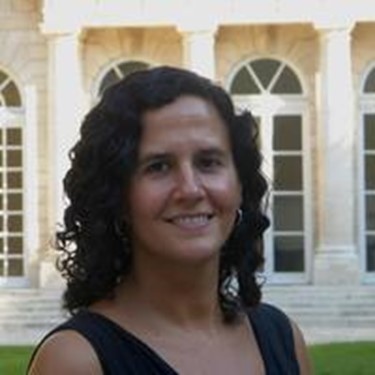BGHS.NEWS
Architecture and Politics
Architecture and Politics

Sara Núñez Izquierdo (Foto: usal.academia.edu)
From 6 to 10 May, Sara Núñez Izquierdo, Professor of Art History at the University of Salamanca, was a guest at the Department of History. On 7 May, she held an event at the BGHS, where she first commented on research projects by two BGHS doctoral researchers and then presented her own research work on architecture in the Franco period in Spain.
Two BGHS members took the opportunity to discuss their work with Sara. Jacob Krusche presented his project on practices of legitimisation of violence in rural Mexico. He conceptualises violent actors as organisations that perform basic control and arbitration functions beyond state authority. Jacob was able to benefit in particular from Sara's experience with the oral history method and is already planning a stay at the University of Salamanca. Anastasia Serikova then presented her project on the representation of famines in museums in Ireland and Kazakhstan. She explores the question of what influence the political systems - the democratic system in Ireland and the authoritarian system in Kazakhstan - have on the presentation of famines as 'difficult heritage' in museums. Sara was also able to provide helpful tips on this with her museological experience and expertise.
Alcalá Street (Madrid). 1959 Spanish Cultural Heritage Institute. Ministry of Culture. 1959. Photo: Juan Miguel Pando Barrero
In her own presentation with the title "New Politics, New Architecture. Spanish Architecture during the Francoism (1939-1975)", Sara took the audience to her home town of Salamanca, whose architecture is strongly characterised by the Franco dictatorship (1939-1975). She talked about the difficulties she initially encountered during her research, because no one before her had ever had the idea of exploring the Franco era through the architecture that characterised it. Salamanca was particularly suitable for this because, unlike in other Spanish cities, hardly any bombs fell there during the Civil War. You can still find plenty of evidence of the Franco dictatorship today, as the photos presented by Sara showed. Under Franco, a new type of architecture was to be created, which above all had features of historicism and was not to be influenced by contemporary architecture in other countries. And so one can get the impression from Salamanca that some buildings are very old, although they were actually only built in the 1940s.
Sara pointed out that many inhabitants of Salamanca take the evidence of the Franco era for granted. Only gradually is an understanding developing that these are testimonies to a brutal regime that need to be placed in their historical context. And Sara's work makes an important contribution to this.
The event with Sara Núñez Izquierdo was very successful because it brought many unusual and exciting aspects into view and highlighted the current relevance of historical research. Sara is also Vice Dean for Internationalisation at the Faculty of Geography and History and Erasmus Coordinator in the Department of Art History at the University of Salamanca. If you are interested in a stay in Salamanca, please contact Bettina Brandt (bettina.brandt@uni-bielefeld.de) for more information.